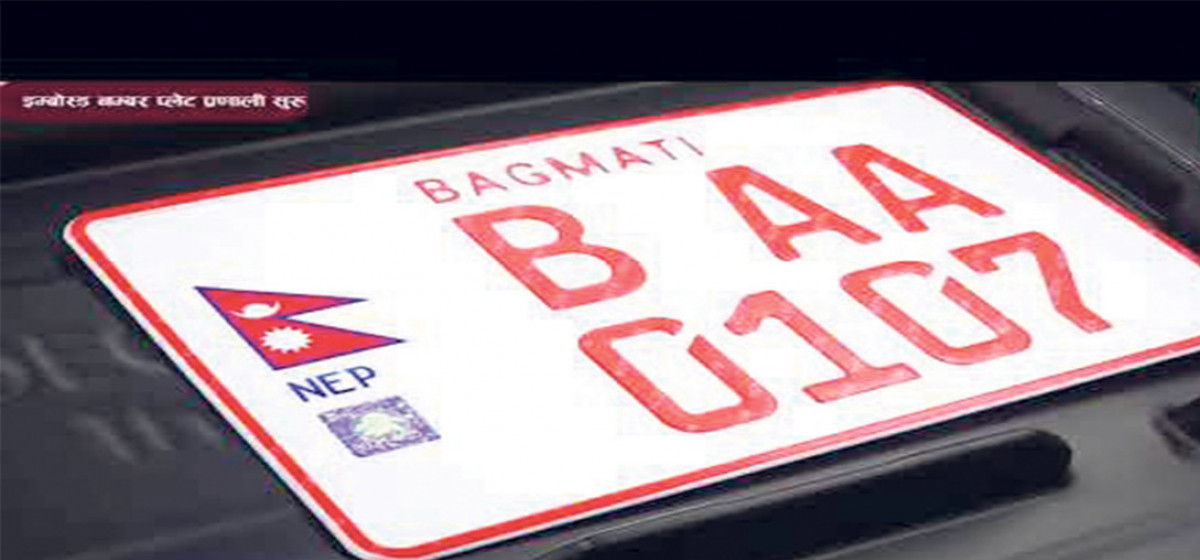
OR
You will face action if you do not get an embossed number plate for your vehicle by mid-July
Published On: June 5, 2022 02:35 PM NPT By: Himal Lamsal

KATHMANDU, June 5: The Department of Transportation Management (DoTM) has decided to take strict action against the owners of vehicles who do not get embossed number plates for their vehicles. The DoTM recently issued a public notice stating that legal action will be taken against the vehicle owners in Bagmati and Gandaki provinces if they do not affix embossed number plates to their vehicles by mid-July this year.
According to the prevailing laws and regulations of the Department, everyone should attach embossed number plates to their vehicles without any further delay. All small and big vehicle owners of Bagmati Province have been instructed to get embossed number plates for their vehicles by visiting the Transport Management Office in Ekantakuna, Lalitpur while people with two-wheelers have been requested to go to the Department's office in Gurjudhara. The Transport Management Office under Gandaki Province has instructed all the vehicles registered in Pokhara and its subordinate offices.
According to DoTM Director General Namraj Ghimire, vehicle owners have been informed not to delay the installation of the embossed number plates. “Many owners delayed the installation of embossed number plates. That is why we have asked them to do this work immediately,” he said.
Earlier, the Ministry of Physical Infrastructure and Transport had issued a notice in the national gazette mandating the installment of embossed number plates in all vehicles on November 1. In the first phase, the government has made it mandatory to install embossed number plates on public vehicles, tourist vehicles, private vehicles, newly registered vehicles of government and institutions in Bagmati, Gandaki, Lumbini, Karnali and Sudurpaschim provinces.
The government has made embossed number plates mandatory in all provinces except for Province 1. However, the Department has not prepared the necessary infrastructure to regulate and inspect the embossed number plates, sparking protests from vehicle owners.
The DoTM has not prepared the necessary technology and equipment for the use of embossed number plates and the necessary infrastructure including data center, control room, satellite connection, RFID sticker, readable device and towers.
The Department had announced plans to set up RFID stations at 10 places in the Kathmandu Valley, including Thankot, Pharping, Jagati, Jorpati and Nagarjuna and five other places outside the Kathmandu Valley for vehicle monitoring and inspection. But so far no inspection and monitoring infrastructure has been constructed other than the installment work of embossed number plates.
Director General Ghimire said that the infrastructure including RFID stations will be built after embossed number plates are attached to the vehicles. "First of all, we have to install embossed number plates on the vehicles," he said.
The service recipients have complained that the embossed number plates break quickly and there are problems including crushing. Director General Ghimire said that such a problem is more prevalent in two wheelers than in four wheelers.
An economic survey carried out by the Ministry of Finance has shown that embossed number plates have not been installed in an efficient manner. The survey states that as many as 135,341 embossed number plates have been produced of which just 8,367 have been installed in vehicles till mid-February.
The cost of installing an embossed number plate for two-wheelers is Rs 2,500, Rs 2,900 for three-wheelers and RS 3,200 for small four-wheelers and Rs 3,600 for bigger vehicles.
The embossed number plates come with microchips that enable the government to maintain uniformity in the issuance of number plates and prevent duplication. Similarly, the new number plates also help the authorities to maintain digital records of vehicles plying the roads, to collect revenue on time and control auto theft.
The plan to launch embossed number plates was included in the Three-Year Interim Plan 2007-10, but it remained in limbo for about a decade due to a number of reasons. The Commission for the Investigation of Abuse of Authority (CIAA) had intervened in the project following a complaint regarding irregularities in 2010.
You May Like This

Embossed number plate can now be written in both English and Nepali
KATHMANDU, April 5: The government has made necessary arrangements for the embossed number plates attached to vehicles to be written... Read More...

Embossed number plates installed on 35,000 vehicles in six years
KATHMANDU, Dec 25: Embossed number plates, which are considered important for vehicle safety, have been installed only on 35,000 vehicles... Read More...

Embossed number plates installed on less than two percent of vehicles
KATHMANDU, Nov 1: The process to install embossed number plates on vehicles which is considered vital for the safety of... Read More...










Just In
- Japanese envoy calls on Minister Bhattarai, discusses further enhancing exchange through education between Japan and Nepal
- Heavy rainfall likely in Bagmati and Sudurpaschim provinces
- Bangladesh protest leaders taken from hospital by police
- Challenges Confronting the New Coalition
- NRB introduces cautiously flexible measures to address ongoing slowdown in various economic sectors
- Forced Covid-19 cremations: is it too late for redemption?
- NRB to provide collateral-free loans to foreign employment seekers
- NEB to publish Grade 12 results next week








Leave A Comment